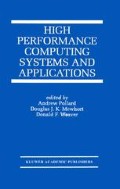Abstract
The “structured-universe approach” is a high-level formalism for capturing and formalizing the phenomenon of irregularity and dynamicity of spatial structures of parallel algorithms. It is the central concept of a data parallel programming model, called UNIVERSE, whose main design objective was to convey the information needed for a successful automatization of a locality-preserving mapping of the logical spatial structures onto distributed-memory machines.
The Salishan Problems are four problems that were designed to challenge the capability of programming models of dealing with irregularity and dynamicity of data structures. This paper illustrates the structured-universe approach by employing it in algorithms for two of the Salishan Problems. It may also serve as a tutorial for this concept of UNIVERSE.
This work was supported by the Real World Computing Partnership, Japan.
Access this chapter
Tax calculation will be finalised at checkout
Purchases are for personal use only
Preview
Unable to display preview. Download preview PDF.
References
Feo, J. T., editor (1992). A Comparative Study of Parallel Programming Languages: The Salishan Problems, volume 6 of Special Topics in Supercomputing. North-Holland, Amsterdam, The Netherlands.
Giavitto, J. L., Michel, O., and Sansonnet, J. P. (1996). Group-based fields. In Ito, T., Halstead, Jr., R. H., and Queinnec, C., editors, Parallel Symbolic Languages and Systems, International Workshop PSLS’95, Beaune, France, October 1995, Proceedings, number 1068 in Lecture Notes in Computer Sciences, pages 209–215. Springer-Verlag.
HPF (1993). High Performance Fortran Forum. High Performance Fortran language specification. Scientific Programming, 2(1, 2): 1–170.
Koelbel, C., Mehrotra, P., and Rosendale, J. V. (1990). Supporting shared data structures on distributed memory machines. In Proceedings of the Second ACM SIGPLAN Symposium on Principles and Practice of Parallel Programming, Seattle, WA.
Li, K. (1986). Shared Virtual Memory on Loosely Coupled Multiprocessors. PhD thesis, Yale University.
Michel, O. (1995). Design and implementation of 8 1/2, a declarative data-parallel language. Technical Report 1012, Laboratoire de Recherche en Informatique, Université de Paris-Sud.
Mirchandaney, R., Saltz, J., Smith, R., Nicol, D., and Crowley, K. (1988). Principles of runtime support for parallel processors. In Proceedings of the Second International Conference on Supercomputing, pages 140–152, St. Malo, France.
Mössenböck, H. and Wirth, N. (1991). The programming language Oberon-2. Structured Programming, 12.
Schramm, A. (1997). A Programming Model for Massive Parallelism. Dissertation, Technische Universität Berlin.
Schramm, A. (1999a). Formalization of spatial structure. RWC Technical Report TR-98-011, Real World Computing Partnership, Japan.
Schramm, A. (1999b). The Programming Language Extension UNIVERSE (provisional Oberon version). http://www.first.gmd.de/~schramm/UNIVERSE-Oberon.ps.gz.
Thornley, J. (1993). Integrating functional an imperative parallel programming: CC++ solutions to the Salishan Problems. Technical report CS-TR-93-40, Computer Science Department, California Institute of Technology.
Author information
Authors and Affiliations
Editor information
Editors and Affiliations
Rights and permissions
Copyright information
© 2002 Kluwer Academic Publishers
About this chapter
Cite this chapter
Schramm, A. (2002). The “Structured-Universe Approach” for Irregular and Dynamic Spatial Structures. In: Pollard, A., Mewhort, D.J.K., Weaver, D.F. (eds) High Performance Computing Systems and Applications. The International Series in Engineering and Computer Science, vol 541. Springer, Boston, MA. https://doi.org/10.1007/0-306-47015-2_24
Download citation
DOI: https://doi.org/10.1007/0-306-47015-2_24
Publisher Name: Springer, Boston, MA
Print ISBN: 978-0-7923-7774-0
Online ISBN: 978-0-306-47015-8
eBook Packages: Springer Book Archive

